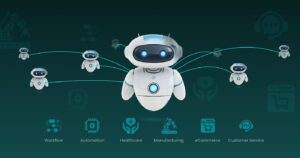Artificial Intelligence (AI) has evolved rapidly over the past decade, transforming industries across the globe. Two of the most talked-about branches of AI today are Agentic AI and Generative AI. While both utilize machine learning to carry out advanced tasks, they serve fundamentally different purposes. In this blog post, I’ll explore what sets them apart, how they function, and how they’re being used in real-world applications.
What is Agentic AI?

Agentic AI refers to systems designed to autonomously perform tasks and make decisions to achieve specific goals. These systems are like intelligent agents, capable of interacting with their environment to solve problems, take actions, or optimize processes without requiring constant human input.
Key Characteristics of Agentic AI:
- Goal-Oriented: At its core, Agentic AI is all about accomplishing a set objective. Whether it’s optimizing a process, taking action based on specific input, or responding to real-time data, the system works towards a defined goal.
- Autonomous Decision-Making: Unlike traditional systems that require human intervention at each step, Agentic AI has the ability to make independent decisions based on pre-programmed logic or learned data. It can act on its own to trigger actions, such as approving an invoice or setting up an appointment.
- Interactive and Adaptive: Agentic AI doesn’t just process information in isolation. It constantly interacts with its environment, adapts to changing conditions, and makes real-time decisions. For example, a virtual assistant like Siri or Google Assistant might use data from your calendar to schedule meetings or remind you of upcoming tasks, adjusting its actions as new information comes in.
Examples of Agentic AI:
- Autonomous Vehicles: These self-driving cars use Agentic AI to make critical decisions in real-time, such as when to brake, accelerate, or change lanes.
- Robotic Process Automation (RPA): Tools powered by Agentic AI automate repetitive tasks like data entry or invoice processing, freeing up employees for more strategic work.
- Virtual Assistants: Platforms like Amazon Alexa and Google Assistant interact with users and other devices, managing schedules, responding to queries, and carrying out tasks autonomously.
Applications of Agentic AI: Agentic AI plays a significant role in industries where efficiency and real-time decision-making are paramount. From customer support chatbots and self-service platforms to complex robotics in manufacturing, Agentic AI is designed to handle a variety of operational tasks without human intervention.
What is Generative AI?
Generative AI, in contrast, is focused on creating new data based on learned patterns from existing datasets. Unlike Agentic AI, which executes actions, Generative AI produces output such as text, images, or music, making it especially powerful in creative industries.
Key Characteristics of Generative AI:

- Creative Output: The primary function of Generative AI is to generate new content that mimics the patterns it has learned from large datasets. It doesn’t simply repeat what it has been taught but creates something new based on input prompts.
- Data-Driven Learning: Generative AI models are trained on massive datasets, from text to images, allowing them to understand patterns and generate content that aligns with those patterns. For instance, a language model like GPT-3 is trained on vast amounts of text data and can generate coherent and contextually relevant responses.
- Predictive Generation: Rather than taking action in response to an environment, Generative AI generates content by predicting what should come next in a sequence. For example, it can generate the next word in a sentence, create a piece of music, or design an image based on a given description.
Examples of Generative AI:
- GPT-3 (Generative Pre-trained Transformer): OpenAI’s GPT-3 is one of the most powerful text-generating models available today, capable of creating human-like text based on prompts. It can write essays, stories, and even provide customer support responses.
- GANs (Generative Adversarial Networks): These networks are used to generate realistic images, videos, or audio. GANs operate through two models—a generator and a discriminator—that work together to produce lifelike outputs.
- DALL-E: Another OpenAI model, DALL-E, can generate images from textual descriptions, such as creating artwork based on a simple prompt like “a cat wearing a space suit.”
Applications of Generative AI: Generative AI has made waves in creative fields, enabling content creators, marketers, and designers to generate everything from advertisements to artwork. Beyond creativity, it also has practical applications in healthcare (e.g., generating synthetic medical data for research), finance (e.g., generating realistic financial data for model training), and even software development (e.g., generating code snippets).
Agentic AI vs Generative AI: A Comparative Overview
While Agentic AI and Generative AI are both subsets of artificial intelligence, they serve vastly different purposes. Let’s break down their key differences:
Agentic AI is designed to perform actions and make decisions in pursuit of a goal. It focuses on executing tasks autonomously. For instance, an autonomous vehicle makes decisions to navigate a road, a customer support bot interacts with users to solve queries, and RPA tools automate business workflows.
On the other hand, Generative AI focuses on creating content based on patterns learned from data. It generates new text, images, or audio that resembles the data it was trained on. Examples of Generative AI include models like GPT-3, which can write essays and generate code, or GANs, which can produce realistic images and videos.
While Agentic AI interacts with its environment to take specific actions, Generative AI creates new content from learned patterns. Think of Agentic AI as the decision-maker and performer, whereas Generative AI is the creative engine.
How Do Agentic AI and Generative AI Work Together?
Although they serve different functions, Agentic AI and Generative AI can complement each other in many use cases. For example:
- In Intelligent Assistants: An intelligent assistant could use Agentic AI to interact with users, manage schedules, and make decisions, while using Generative AI to create responses, generate reports, or even craft personalized emails.
- In Business Automation: Agentic AI can automate tasks like data entry or customer query routing, while Generative AI could be employed to generate content such as marketing materials, social media posts, or even new product descriptions.
By combining these two AI capabilities, businesses can enhance productivity, streamline workflows, and create innovative solutions across various domains.
Conclusion

Both Agentic AI and Generative AI offer unique capabilities that are transforming industries in different ways. Agentic AI focuses on autonomous decision-making and executing tasks, making it invaluable for operational processes and business automation. Generative AI, on the other hand, excels at content creation, enabling new possibilities in creative industries and data-driven sectors.
By understanding their distinctions and complementary nature, businesses can harness the full power of both technologies. As AI continues to evolve, the line between these two branches may blur even further, leading to more integrated and intelligent systems that not only make decisions but also create and innovate.
Feel free to share your thoughts in the comments—how do you see Agentic AI and Generative AI shaping the future of your industry?

